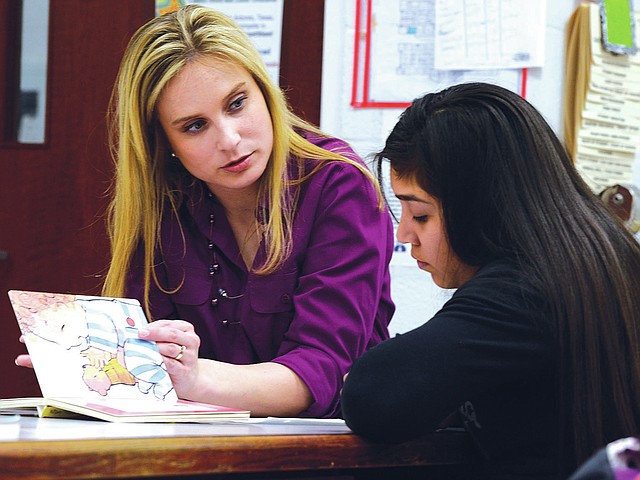Cultural Diversity In School Staff Helps Students, Northwest Arkansas Schools Trying To Recruit More Minority Educators
Northwest Arkansas Schools Trying To Recruit More Minority Educators
STAFF PHOTO ANTHONY REYES Fortenberry talks with Yoselyn Armas, 14, about the book she is reading at George Junior High School.
Saturday, April 26, 2014
Edith Gonzalez said she's Hispanic and thinks having more teachers of her ethnicity in Northwest Arkansas schools could be a positive change.
The largest student ethnic demographic in Springdale, at 45 percent this school year, and Rogers, at 43 percent last year, is Hispanic, according to district officials. However, the majority of teachers and administrators in the Bentonville, Rogers, Springdale and Fayetteville school districts are Caucasian.
By The Numbers (w/logo)
School Demographics
Staff means certified teachers and administrators, except for Bentonville which includes teacher aides. Some statistics came out as 0 percent in district calculations, but there may be a couple teachers or administrators in that category.
Bentonville (2013-14)
• Caucasian: students: 76 percent, staff: 77 percent
• Hispanic: students: 11 percent, staff: 11 percent
• African American: students: 3 percent, staff: 5 percent
• Native American: students: 1 percent, staff: 3 percent
• Native Hawaiian/Pacific Islander: students: 0 percent, staff: unknown
• Asian: students: 5 percent, staff: 2 percent
• Two or more ethnicities: students: 4 percent, staff: unknown
Springdale (2013-14)
• Caucasian: students: 39 percent, staff: 87 percent
• Hispanic: students: 45 percent, staff: 10 percent
• African American: students: 3 percent, staff: 1 percent
• Native American: students: 1 percent, staff: 1 percent
• Hawaiian/Pacific Islander: students: 10 percent, staff: 0 percent
• Asian: students: 2 percent, staff: 1 percent
Fayetteville (2013-14)
• Caucasian: students: 72 percent, staff: 94 percent
• Hispanic: students: 10 percent, staff: 1 percent
• African American: students: 12 percent, staff: 4 percent
• Native American: students: 1 percent, staff: 0 percent
• Hawaiian / Pacific Islander: students: 1 percent, staff: 0 percent
• Asian: students: 4 percent, staff: 0 percent
Rogers
• Data unavailable for 2013-14
Source: Staff Report
"Our teaching demographics do not match our student demographics," said Roger Hill, Rogers assistant superintendent for human resources.
Officials in the Springdale School District recognize the need for more minority teachers. The district is advertising in a magazine called "Minorities & Success" and its online counterpart called Minority Success Network, said Jared Cleveland, deputy superintendent for personnel. Officials also visit career fairs at universities for recruitment efforts, said Marsha Jones, associate superintendent for curriculum, instruction, accountability and education innovation.
The website and publication focus on introducing women and minorities to job opportunities through postings on the site and in the magazine. Job seekers can also read company profiles to learn more about potential employers.
It helps students to have a cultural connection to teachers and administrators, said Patricia Griffen, president of the Arkansas Psychological Association.
"Students gravitate toward someone they have a connection to," she said.
Edith, an eighth-grader at George Junior High School in Springdale, said Hispanic students would probably ask a Hispanic teacher for help more often than a teacher from another ethnic background.
"They'll have more of a chance of understanding," she said.
Cultural diversity at school can help all students learn to socialize, Griffen said. With different cultures represented by their teachers, students can learn about culture from the school staff as well as their peers.
Jennifer Fortenberry, family and consumer sciences teacher at George, is Caucasian and said the majority of her students are Hispanic. She said she bridges the culture gap by learning about her students, their families and way of life.
"It's about caring about them," she said. "It's just getting on that personal level. You can't fake it."
Fortenberry said she has to teach many of her students concepts that aren't culturally familiar to them. One of those concepts is the proper way to set a table.
"I have to teach where a fork goes, and a knife and a spoon," she said.
Fortenberry said she has also learned about the norms of her students' cultures. She learned many Hispanic families don't use a dishwasher for washing dishes. They hand-wash the dishes with a bowl of water and use the machine for storage.
If children don't learn about different cultures, they could say something that someone from another culture might perceive as insensitive, Griffen said. It can result in minority students feeling misunderstood.
Feeling misunderstood can lead to stress, Griffen said. Stress can lead students to perform poorly in class.
Griffen calls the lack of knowledge a "cultural divide."
The Rogers School District is using grant money from the Walton Family Foundation to balance the disparity, Hill said. The grant money is used as an incentive to hire out-of-state minority teachers to work for the district. They receive $2,000 toward the cost of moving and a $5,000 bonus at the beginning of their sixth year in the district.
Officials in the Rogers and Fayetteville districts also travel to colleges with large numbers of minority students to recruit staff members.
Hill said he attends two out of state career fairs every spring. Officials in the Fayetteville School District go to University of Arkansas at Pine Bluff every year for recruitment efforts, said John L Colbert, associate superintendent.
NW News on 04/26/2014